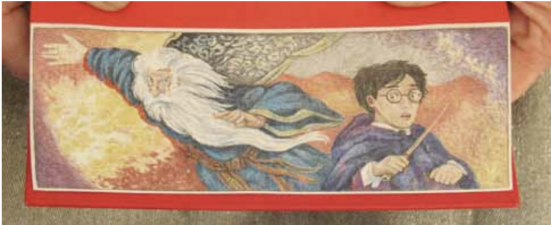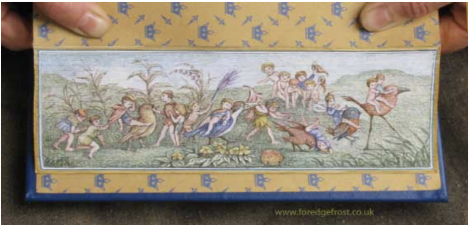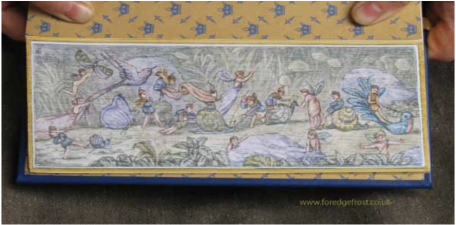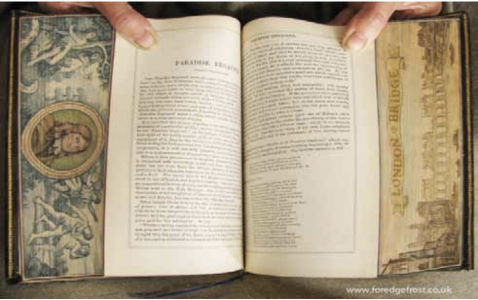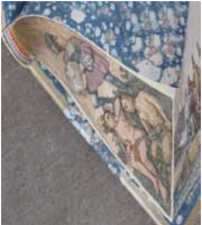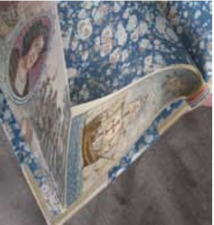Fore-Edge Painting
A painting located most notably on the fore-edge of a book but with different variantions and styles exploring every side.
Introduction

During the sixteenth century, the world was gifted with a new art form that completely transformed the appearance of the everyday bookshelf. What once was a drab looking wooden shelf filled with the same color of paper could now be the new centerpiece of one’s home. You may have come across this newfound artform while you were previewing the side of a book or it could have magically appeared as you flipped to the center of your family Bible. You may have even contributed to the vast library of fore-edge paintings when you drew on one your textbooks during primary school—yes, this does count if it was on the edge of the book. This article seeks to delve deeper into the world of fore-edge paintings and explore their origin, history, how they’re made, what they’re used for, the differing variations, and their use in today’s world while taking an in-depth exploration of various books in and their magnificent examples of the fore-edge painting.
Birth of Fore-Edge Painting
Since the beginning of the bound codex, humans always found a use for the fore-edge of the book. In the earlier centuries, people would often sign their names and/or the titles of the book directly onto the fore-edge. This was done so that people could organize and identify different books when surveying a bookshelf. As Phillips notes, “The earliest of [these] fore-edge paintings date back to around the 10th century, and the earliest signed and fore-edge book dates to 1653, which is a family coat of arms painted on a Bible.” [1] In Venice, Italy, during the 16th century, an artist with a new idea for what could belong on the fore-edge was emerging. It is here that the original/traditional definition of what a fore-edge painting would come to mean was born.[2]
Cesare Vescellio decided that the tradition of writing the title of the book on the fore-edge could be spruced up and “devised a way to enhance the beauty of a book by painting on its edges.”[2] This is where the traditional method of painting directly onto the fore-edge was created. These paintings ranged from landscapes to religious iconography to family crests/seals. These images are still frequently used in modern fore-edge paintings.
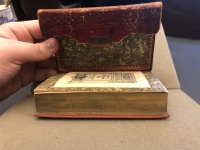
After a full century of painting directly onto the fore-edge, a new method was created by Samuel Mearne in England. Mearne, bookbinder to King Charles I, developed a new form of fore-edge painting which utilizes a gilded edged paper that shrouds a beautiful painting hidden on the inner-edges of the book’s pages. This form of the fore-edge painting would soon be known as the vanishing fore-edge painting. While this method was created in the 17th century, it didn’t become popular until the late 18th century “‘by Edwards of Halifax, who was already known for his exquisite bindings, and who by adding a fore-edge painting to an already fine binding, was creating the ultimate luxury item.’””[1] During this time, “artists were employed to paint landscape scenes with country estates on the fore-edges of books, which were then handsomely bound in painted vellum covers or in exotic leather bindings.””[2]
Exploration of a Bible from Father to Daughter

It is true that while examining these pieces of artwork at the Kislak Center located at the University of Pennsylvania, I found that most of these works of art were bound in intricate leather bindings. The fore-edge paintings often felt more along the line of a message that signified wealth or class and in my observation were often given as gifts to loved ones. As you can see in this example of a smaller Bible in Figure 1 and 2, a gift from a wealthy father to his daughter, the book is bound in beautiful leather with a small, metal clasp that allowed the book to be locked for safe storage and for protection of the fore-edge painting hidden within. The gold marbling on this book was so well done and preserved that Jehnna, a friend and worker at the Kislak Center, was dumbfounded as to why I asked to see this specific book since it didn’t appear to have a fore-edge painting. Shortly after, I carefully fanned the fore-edge of the book, and a breathtaking landscape painting of what appears to be a homestead or church emerged from beneath the golden pages. As you can see in Figure 2, the color is still prevalent even after being painted in the early nineteenth century. Two figures can be examined rowing a boat in a river or lake just in front of the main building. To the right, it looks as if a young girl and an older man walk together along a path. If in fact this Bible was given as a gift from a father to his daughter—as it was implied in the handwritten preface,—then maybe these two figures on the right were meant to be the real-life father/daughter pair. While this is purely speculative, this idea of the father/daughter being painted into the Bible itself would further the personalization of the piece and would add not only monetary value but would also be a sweet gesture from parent to child.
How and Why

Originally, fore-edge paintings were painted directly onto the edge of the book. This was during the tiume when people would “‘write an author’s name or book title onto the fore-edge of a book for identification purposes,”’”[1]. This was done mainly because early codexes' bindings could not withstand the pressure of being stored vertically. This would allow early people to store books without harming them in a way that was easy to navigate and differentiate between different texts.
In later years with the emergence of the vanishing fore-edge painting, artists began using a frame to achieve the vanishing technique. The frame used for this technique would exert pressure onto the book while the edges were fanned and visible. In doing so, the inner-edges of the book’s sides would be revealed and were stable enough for artists to begin painting on. After the paint has been fully dried, a marbling can then be added to the edge to form a vanishing fore-edge painting. Martin Frost, one of today’s commercial fore-edge painters describes the method as: “‘the page block is fanned and an image applied [sic] to the stepped surface. If the page edges are themselves gilded or marbled, this results in the image disappearing when the book is relaxed. When re-fanned, the painting magically re-appears.”’[3]
Vanishing fore-edge paintings, in my opinion, do not appear to be major forms of identification like its early predecessor. The vanishing fore-edge is often used as an expensive embellishment to any codex. While the hidden picture can tell someone what book they are looking at, it would require more work than the original/non-vanishing painting. This is where I have decided to completely divide the two forms. While the traditional painting may also be an embellishment to a book, it could still act as a method of identification since it is easily visible, unlike the vanishing painting.
In Figure 3, one of Martin Frost's modern fore-edge paintings, which pictures what appears to be seafarers landing on new earth, the book is still secured in the frame. As you can see, the frame holds the book in two places with a wooden bar stretched between two rods. The two rods would then be twisted, allowing the wooden bar to compress onto the book as it is being fanned. Once the bar has been tightened until the book is unmovable, the artists can then begin painting. These paintings can be applied to various areas of the book and in different ways.
Variations
There are two main archetypes of the fore-edge painting, the traditional and vanishing, but these two forms can even be further dissected into smaller subcategories:
Single:
A single painting located on the fore-edge of the book. If it’s vanishing, the pages will need to be fanned in order to reveal the painting.
- Screenshot of Harry Potter Philosopher’s Stone, Gryffindor RED by Martin Frost.
-
Double:
Two paintings located on the fore-edge of the book. To access the paintings, the fore-edge will need to be fanned to the right for the first image. To access the second image, the fore-edge will need to be fanned in the opposite direction.
- Screenshot of TWO-WAY DOUBLE of a classic fairytale title from Fore-edge painted Books for sale by Martin Frost.
-
-
Split:
Two paintings are located on the fore-edge. To access them, the book must be opened halfway through. The paintings will reveal themselves on both sides of the book
- Screenshot of SPLIT DOUBLE of John Milton and Old father Thames by Martin Frost.
-
All-Side:
Paintings are located on every edge of the book. To access the paintings, it’s a bit trickier than the previous versions since the edges will need to be fanned and pinched up from the corners in order to reveal the hidden painting.
- Screenshot of Life of Christopher Columbus by Martin Frost
-
-
-
Comparision of the Traditional and Vanishing
As discussed above, there are two main categories of fore-edge paintings, traditional and vanishing. These two different fore-edge painting styles can be clearly examined in the Bibles: Biblia sacrosancta Veteris ac Noui Testamenti: adiectis ex eruditis scriptoribus scholijs, ita, vbi opus est, locupletibus, vt pro commentarijs sint: multis certè locorum millibus praesertim difficilioribus, lucem afferunt / auctore Isidoro Clario Brixiano ... ex secunda eius recognitione. Deputatorum Concilij Tridentini seruata censura and The Holy Bible: containing the Old Testament and the New, newly translated out of the original tongues, and with the former translations diligently compar'd & revis'd: by His Majesty's special command, appointed to be read in churches.
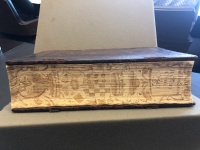
The latter printed in Venice, Italy, in 1564, features a traditional fore-edge painting that is utilized as decor for the Bible. In contrast, the other Bible comes from 1694 London.
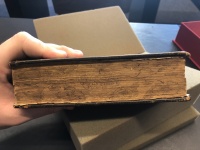
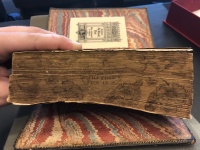
It features a vanishing fore-edge painting that appears to be an embellishment as well. These two fore-edge paintings serve as perfect examples of the traditional fore-edge painting emerging in Venice, Italy, during the sixteenth century and the creation of the vanishing fore-edge painting during seventeenth century England.
As you can see in Figure 4 of the sixteenth-century fore-edge painting, the artist does not use any color other than the shade, black, which has been muddied down to more of a brown. A crest is clearly visible in the center of the fore-edge and is surrounded by intricate flowers, flags, and other artwork. At the right of the picture, but the top of the Bible, there appears to be an enclosed box with the title of the book being written within it: Biblia Sacra. I was surprised to see this at first since this is a vertical fore-edge painting, which means this book was not probably stored horizontally. Since this book was in Latin and was bound in a beautiful brown leather, I wonder if this was used either within a high-class household or within a church. The two aspects of a crest and title being painted onto the fore-edge were extremely prominent during this century, especially being from the birthplace of the fore-edge painting. This Latin Bible provides us with a perfect example of traditional fore-edge paintings.
Figure 5 and 6 show the seventeenth-century fore-edge painting on an English Bible. Inside the pages, it is noted that the Bible was a gift to a woman, possibly Margrat, in London. While the marbled edge has worn a bit and the splitting of the spine caused trouble fanning the fore-edge, I was able to capture at least enough of it to decipher what the painting pictures. The fore-edge painting showcases a heart at the center encased by flowers and vines. Inside of the heart appears to be a Bible verse as well as the name, Jesus Christ, and Proverbs 12.4. Upon looking up the verse, "A good wife is the crown of her husband,"[4] it makes me wonder if this was a wedding gift from someone to this woman. While this book doesn't appear to be as intricate as the Bible from the father to the daughter, I would guess it did cost a considerable amount of money during this time period.
Fore-Edge Painting Today
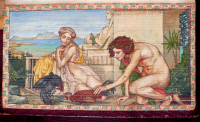
After taking a look at older iterations of the fore-edge painting, it's time to glance at how the art form has transformed over the centuries. In fact, the fore-edge paintings of today often involve new iconography. One may find erotic images or even pictures from novels or films. This was something highly unusual for fore-edge paintings in previous centuries and is a newfound way of reimagining the classical artform.[5][6]
“Fore-edge book painting is practiced commercially by only two artists,” Clare Brooksbank and Martin Frost.[7] These two artists currently are based out of the United Kingdom. Clare describes her work as: “I have an interest in the human form and with what it means to be a woman. I use classical mythology, literature and films aswell [sic] as my own experiences to analyse views of women in the world. In my work I use the female form to show how subtle changes of shape in the outer expression can tell of shifts in the depths of the psyche. By combining charcoal drawings or paintings in oil with collaged text from film scripts, classical literature or my own writing I create a rich layering of script and image to express life experiences and emotions.”[6]

In Figure 7 and 8 are examples of some of Clare's work. You can tell that she ventures a bit further away from the typical fore-edge paintings from earlier centuries. This can be witnessed specifically within Figure 7, which pictures what appears to be an almost nude couple watching a cockfight. In Figure 8, Clare paints a woman looking out into a storm-driven sea with a ship appearing to almost sink beneath the waves. I find these two pictures to be completely different from what I was viewing in the Kislak Center. These images don't seem to shy away from harsh or erotic material.
As for Martin Frost, you can view several of his fore-edge paintings in the variations section of this page. His images often appear to reflect what the text is about, such as his Harry Potter painting under the single section. That painting is located on a Harry Potter and the Philosopher's Stone book. He has several of his art pieces available for purchase on his website as well. What I found interesting about these specific paintings of Harry Potter iconography was the gilding that was used to create the vanishing effect. In all instances of books that I surveyed with a vanishing fore-edge painting, they all had a golden gilded edge, but Frost's Harry Potter paintings had a silver with stars for the gilded edge. I guess this is a new technique for the modern fore-edge painter.
Conclusion
Fore-edge paintings are a unique quality to any book. From the beginning where paintings signified ownership and/or title to the artform of painting landscapes and ertoic images, the fore-edge has been a home for artistic growth within the bound codex.
Notes
- ↑ 1.0 1.1 1.2 Phillips, Jack. “What's a Fore-Edge Painting?” The Epoch Times, 09 Dec 2015. https://www.theepochtimes.com/whats-a-fore-edge-painting_1910333.html
- ↑ 2.0 2.1 2.2 Bromer, Anne C. “On the Edge.” Fore Edge Painting - An Introduction | On the Edge. http://foreedge.bpl.org/node/923
- ↑ “The Curious Art of Secret Fore-edge Painting” ANE Online. 09 Sept 2016. http://artnewengland.com/event/the-curious-art-of-secret-fore-edge-painting/
- ↑ “Proverbs 12:4” Revised Standard Edition. BibleGateway. https://www.biblegateway.com/passage/?search=Proverbs+12%3A4&version=RSV/
- ↑ “Fore-Edge Painting” Wikipedia, Wikimedia Foundation. https://en.wikipedia.org/wiki/Fore-edge_painting/
- ↑ 6.0 6.1 Dave. “Clare Brooksbank Art” Clare Brooksbank Art - About Clare. https://www.clarebrooksbank.co.uk/index.php/about-clare
- ↑ “Clare Brooksbank Art” Clare Brooksbank Art - Gallery - Fore-Edges. https://www.clarebrooksbank.co.uk/index.php/category/1-foredge/
